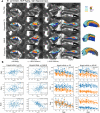Automated hippocampal unfolding for morphometry and subfield segmentation with HippUnfold
- PMID: 36519725
- PMCID: PMC9831605
- DOI: 10.7554/eLife.77945
Automated hippocampal unfolding for morphometry and subfield segmentation with HippUnfold
Abstract
Like neocortical structures, the archicortical hippocampus differs in its folding patterns across individuals. Here, we present an automated and robust BIDS-App, HippUnfold, for defining and indexing individual-specific hippocampal folding in MRI, analogous to popular tools used in neocortical reconstruction. Such tailoring is critical for inter-individual alignment, with topology serving as the basis for homology. This topological framework enables qualitatively new analyses of morphological and laminar structure in the hippocampus or its subfields. It is critical for refining current neuroimaging analyses at a meso- as well as micro-scale. HippUnfold uses state-of-the-art deep learning combined with previously developed topological constraints to generate uniquely folded surfaces to fit a given subject's hippocampal conformation. It is designed to work with commonly employed sub-millimetric MRI acquisitions, with possible extension to microscopic resolution. In this paper, we describe the power of HippUnfold in feature extraction, and highlight its unique value compared to several extant hippocampal subfield analysis methods.
Keywords: Brain Imaging Data Standards; computational anatomy; deep learning; hippocampal subfields; hippocampus; human; image segmentation; magnetic resonance imaging; neuroscience.
© 2022, DeKraker et al.
Conflict of interest statement
JD, RH, MY, BK, JL, SK, AK No competing interests declared
Figures











References
-
- Berron D, Vieweg P, Hochkeppler A, Pluta JB, Ding S-L, Maass A, Luther A, Xie L, Das SR, Wolk DA, Wolbers T, Yushkevich PA, Düzel E, Wisse LEM. A protocol for manual segmentation of medial temporal lobe subregions in 7 Tesla MRI. NeuroImage. Clinical. 2017;15:466–482. doi: 10.1016/j.nicl.2017.05.022. - DOI - PMC - PubMed
-
- Blümcke I, Thom M, Aronica E, Armstrong DD, Bartolomei F, Bernasconi A, Bernasconi N, Bien CG, Cendes F, Coras R, Cross JH, Jacques TS, Kahane P, Mathern GW, Miyata H, Moshé SL, Oz B, Özkara Ç, Perucca E, Sisodiya S, Wiebe S, Spreafico R. International consensus classification of hippocampal sclerosis in temporal lobe epilepsy: a task force report from the ILAE Commission on diagnostic methods. Epilepsia. 2013;54:1315–1329. doi: 10.1111/epi.12220. - DOI - PubMed
-
- Bookheimer SY, Salat DH, Terpstra M, Ances BM, Barch DM, Buckner RL, Burgess GC, Curtiss SW, Diaz-Santos M, Elam JS, Fischl B, Greve DN, Hagy HA, Harms MP, Hatch OM, Hedden T, Hodge C, Japardi KC, Kuhn TP, Ly TK, Smith SM, Somerville LH, Uğurbil K, van der Kouwe A, Van Essen D, Woods RP, Yacoub E. The lifespan human connectome project in aging: an overview. NeuroImage. 2019;185:335–348. doi: 10.1016/j.neuroimage.2018.10.009. - DOI - PMC - PubMed
Publication types
MeSH terms
Grants and funding
LinkOut - more resources
Full Text Sources
Medical

